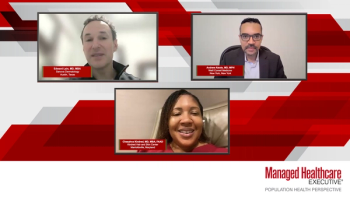
Long-Acting Injectable PrEP Therapy for HIV
Types of patients who will likely benefit from long-acting injectable PrEP therapies in the HIV treatment pipeline.
Episodes in this series

Douglas Krakower, MD: I think that long-acting injectable PrEP [pre-exposure prophylaxis], which will hopefully be available in 2022, is something that could be used for virtually anyone. I think if someone is doing well on oral PrEP, and they want to switch to injectable PrEP, I think that’s absolutely something that people should have the option to do. In terms of the greatest benefit for improving population health and meeting national goals, we need to think about injectable PrEP as a way to not only keep people who are using oral PrEP and using it with adherence and persistence, engaged in PrEP, but how do we get new people and new populations engaged?
If people have marginalized housing, if they have issues with psychosocial challenges like depression, anxiety, PTSD [post-traumatic stress disorder], substance use disorders, all the things that make it challenging to adhere to daily pill-taking, these are populations where I think first and foremost, we want to see if there are ways to integrate the injectable PrEP option into people’s lives in a way that oral PrEP maybe couldn’t. I don’t think there’s ever going to be a one-size-fits-all, so we need to discuss all these options with all the individuals and populations who may be accessing PrEP. We shouldn’t think that we know the right answer for any specific individual and keep an open mind.
I do think that being intentional about engaging new communities in long-acting injectable PrEP could improve what people have termed as the mosaic effectiveness of PrEP, which is not just keeping people who are already on PrEP on PrEP, which they may do with things like oral tenofovir and emtricitabine, which are already in existence and are available in generic forms so it can be a very cost-effective long-term option. But can we get new people onto PrEP? I’m optimistic that there’s a lot of excitement.
There have been studies showing that hypothetical acceptability for long-term injectable PrEP is high in some of the populations that have underused oral PrEP thus far. Maybe this will be a chance to right some of those inequities. People who were in the injectable PrEP studies also gave very high marks to using injectable PrEP, and the vast majority wanted to continue using injectable PrEP. All the avenues point toward going here for engaging new populations. I think we have to be careful because of some of the lessons learned from other long-acting injectable options in terms of HIV treatment, which has also been available for the past year.
I think usage has been slow in my own practice. I talk to dozens of people about long-acting injectable antiretroviral therapy for people who are HIV positive. For the vast majority of them, they’d rather take a pill a day and see me on an annual basis and get laboratory tests done twice a year than come see the nurse in our clinic every 4 weeks. As long-acting injectable agents become less burdensome in terms of the care and the frequency of visits, I think it will expand the options even further. I know that’s still in the pipeline, but there are some agents that are being looked at that maybe could have an every 6-month injection. The future has a lot of different paths that can be taken. As long as we’re thinking about offering long-acting injectable PrEP as an important new option to as many people as possible, I think we’ll see the biggest population health benefits.
Ryan Bitton, PharmD, MBA: As a payor, how would we look to find patients who are eligible or probably should be on a long-acting medication if they’re on short-acting medication? That’s a good question. I think there are a lot of specifics that we’re not going to be able to get at, as far as who the patient is, preferences, etc. We don’t really see that, but we have the ability to look at claims, and so we can say, “You’re on a short-acting, but you fill a monthly prescription every 3 months. You’re not compliant.” That’s an obvious opportunity.
I think you could also look and say if we marry medical benefit data up with pharmacy data, and we say this patient, maybe they’re in an outlying town where there’s no opportunity to get into the clinic more often. We can look at those types of things, but it’s going to be difficult aside from looking at how they’re taking the short-acting. Really, it’s fill rates and how often they’ve got therapy at home to take versus when they don’t, and would a monthly therapy or a monthly administration or some long-acting agent be better for them? We would look at pharmacy claims data, which I think is the best way that we have to figure that out.
Transcript edited for clarity.
Newsletter
Get the latest industry news, event updates, and more from Managed healthcare Executive.

























































